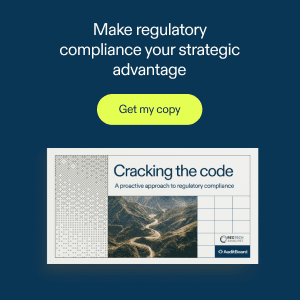While marketing traditionally owns customer experience, today’s CX challenges demand involvement from operations, finance, HR, legal and compliance teams. Protiviti’s Jim DeLoach breaks down why organizations need an “everyone is responsible” mindset and outlines steps for building a customer-centric operation.
How a business engages its customers at every point of their buying journey is critical to connecting the organization’s brand promise to, and delivering on, an exceptional customer experience (CX). Every market-facing function — marketing, sales, customer service and digital platforms, among others — has skin in the game in facilitating the buyer’s overall experience with the company and its products and services. The end game objectives are clear: Positive customer sentiment and strong brand loyalty.
For executive management and the board, measuring CX performance is a key point of focus. There are outcome metrics — such as customer satisfaction, retention and loyalty — that are often staples on the C-suite and boardroom dashboard. But process metrics — such as time to schedule an appointment, wait time in the store, product usage satisfaction, length of time customers are kept on hold when they call customer service, time to resolve a complaint, customer churn rate and referral rate — may be even more important. Because they focus on the various activities that touch the customer, these metrics provide insights into how well a company’s processes are functioning in meeting its objectives and where they should be improved. Excellence in customer engagement touchpoints drive positive outcomes in customer satisfaction, retention and loyalty.
In addition to internally driven process metrics, companies often collect and analyze customer feedback, such as customer satisfaction scores or net promoter scores (NPS), to gain a more direct measure of CX. These metrics can provide valuable insights into how customers perceive their interactions with the company and can likewise help identify areas for improvement.
However, while process and outcome metrics are important, they are just one piece of the puzzle. A comprehensive approach to measuring CX should also consider factors like the quality of the product or service, the effectiveness of customer communications and the overall relationship between the customer and the company.
Why is CX important?
Most marketing professionals agree that the primary purpose of a CX strategy is to improve customer retention and satisfaction. This aspect of strategy-setting is fairly intuitive to senior executives and directors as they recognize that the cost to obtain a new customer is higher than the cost to sell to an existing customer. Some assert it is five to seven times higher. This thinking frames why CX is so important.
It helps to view the various CX touchpoints as the buyer’s journey. CX is often reflected through the customer sentiment throughout the buyer’s journey as well as through customers’ decisions to return to the brand. How well a business understands changes in customer sentiment throughout the buyer’s journey can prove to be decisive in determining its success over time.
The essence of CX is that it is all about a persistent, obsessive focus on the customer, whether the business model is B2C or B2B. CX encompasses everything a business does or should do to put its customers first and manage the processes that engage them both directly and indirectly, with the intention to meet or exceed their expectations and sustain their loyalty. And why is that important? In driving more than two-thirds of customer loyalty, CX outperforms brand and price combined. Yet over 70% of CX leaders struggle to design the appropriate projects and initiatives that would increase customer loyalty and achieve the sustainable growth results they desire.
Guarding the Golden Goose
Tips to preserve your company’s most precious organizational asset
Read moreDetailsBuilding and maintaining CX
If CX is so important, why is managing it so hard? Dynamic markets ensure that strategy, technology, execution and the application of the customer experience are constantly evolving. Customer preferences change. So do communications and customer engagement channels. Privacy regulations and compliance requirements proliferate.
Most importantly, as new strategies and technologies are put in place, issues arise when they are not integrated into CX. When the experience for customers and employees is not designed to work in harmony and CX is neither embedded nor consistently reinforced across all areas of the business, dysfunction results.
Disparate teams or systems send disconnected communications or operate in silos with conflicting goals, creating friction for the customer. Technology may be viewed as an out-of-the-box silver bullet for solving the CX problem. It is also hard to link data to customer value in a secure, privacy-compliant and reliable manner. Bottom line, fragmented systems and ways of working undermine delivery of a seamless, best-in-class customer experience. Thus, deciding where to initiate a focus on CX is challenging.
So, where to start? Following are six suggestions:
Adopt an “everyone is responsible” mindset. When it comes to activating growth through a differentiated customer experience, everyone (e.g., operations, finance, human resources, legal and compliance) in the organization, not just marketing, has a role to play. A clear vision is needed to align multiple parts of the organization toward customer centricity. Focused data and analytics should facilitate understanding of customer needs, design of relevant products and services and reimagining of business models. Platforms and technology should drive change and enable launching at scale through capability building, technology, operating models, measurement and performance. To make it all work, everyone who matters should be on board.
Connect and communicate with customers. In a rapidly changing world, customers have options. Companies should cut through the noise and capture attention throughout the customer journey lifecycle with a high-tech, high-touch approach. Communicating clearly, making it easier to navigate online accounts, sending notifications proactively, letting customers choose how the company communicates with them, honoring their preferences and sending personalized communications are ways of deploying both technology and the human element. Improving timing and relevance is key — e.g., communicate at the point of the lifecycle as close as possible to a moment of need.
Determine the brand’s North Star. Whether the model is B2B or B2C, figure out what end customers want and let it drive the company’s goals with an emphasis on the experience moments that matter. The two should be compatible and comprise the brand’s North Star. Then focus on the most effective way to deliver the customer experience that is consistent with that direction, considering constraints (e.g., technical debt, data not available timely, disconnected systems and AI not fully trained) that cannot be addressed near-term. By allocating resources to improve those moments that have an emotional connection with buyers, the organization creates the very best experience out of its existing capabilities. As for constraints, there is a solution for every problem. If bandwidth is limited, automate repetitive tasks (possibly by leveraging AI tools) to free up time for employees to become effective brand advocates in solving problems and better serving the customer — a win-win for both the company and the customer.
Find the right incentives. Based on the company’s goals and known customer preferences, the appropriate incentives should be implemented to align everyone to the desired outcomes and drive process or technology improvements. The incentives structure should support a seamless operating model from the customer’s perspective.
Pay attention to regulatory requirements. Compliance with laws and regulations governing customer interactions and handling of personal data is an imperative, particularly in financial services. Adherence to data privacy regulations wherever the company operates, clear communications, training customer service personnel on compliance matters, designing products and services that offer a compliant experience, assessing and mitigating potential risks and using customer feedback to identify areas for improvement offer a proactive approach. This builds transparency and trust, manages reputation and provides protections against fines, penalties and lawsuits.
Innovate and improve CX continuously. Managing CX is not a one-and-done exercise. Effective feedback loops with customers should provide insights into ways the company could improve its CX. Augmented with data analysis and predictive analytics, timely feedback drives increased customer satisfaction and loyalty. Customer-facing AI applications offer personalized interactions, proactive issue identification and task automation to enhance the speed and relevance of customer support. However, they must be fully trained to ensure adherence to management’s guidelines and reliability in responding to the prompts customers are most likely to feed them. As companies test these models to ensure they are ready for prime time and compliant with applicable laws and regulations, the fear of missing out is driving the emergence of centers of excellence and, in the content space, the integration of AI into major platforms.
The payoff of a successful CX strategy is improved business performance in terms of revenue growth, lasting customer loyalty, a higher customer lifetime value (the total net profit a company can expect to generate from a customer throughout their entire relationship) and sustainable competitive advantage. Indeed, in the digital age, CX could prove to become the ultimate differentiator. It is the game companies must win.
Implications for executive management and the board of directors
The dynamic nature of meeting and exceeding customer expectations continuously over time requires an organizationwide, cross-functional focus to get it right. Senior management and the board have a vested interest in ensuring that the organization does.
Management should consider the five suggestions above. The board should decide how best to organize its approach to CX oversight. Should it be a matter for the full board, a board committee or a board task force or sub–committee? The technology and privacy underpinnings of CX suggest the need for a technology focus. In a B2C environment, directors can even do their own research by being a “secret shopper.”
Senior executives and directors should set the tone for prioritizing CX by ensuring that an effective strategy and appropriate policies are in place and monitoring relevant and reliable CX metrics integrated into the strategic dashboard. They should engage in resource allocation conversations with an emphasis on understanding how CX improvement opportunities are prioritized, appropriate stakeholders are engaged and improvement initiatives are appropriately led.
Following are some suggested questions that executives and directors should consider, based on the risks inherent in the organization’s operations:
- Are all functions of our organization customer-centric? In other words, is the customer the focal point of their decisions related to managing the costs, elapsed time and quality associated with our products and services and the interactions with our brand?
- Do we have a comprehensive view of our customers that enables us to unlock data, drive insights and inform our CX improvement decisions? How do we know?
- Do we have reliable and relevant CX metrics? If so, do they address the distinctive attributes of the value proposition underlying why customers choose our products, services, processes and interaction points over others? Do our metrics provide insight into those aspects of CX our organization needs to improve?
- How is the emergence of generative AI and other technologies affecting CX and our need to innovate to keep pace with changing customer preferences and needs? Are we connecting our technology investments to measurable customer value and optimizing them to deliver exceptional experiences? How do we know?
- How does our customer experience compare to that offered by our competition? How about in comparison to best CX practices?
- Is our customer experience compliant with applicable laws and regulations? What policies and processes do we have in place that enable us to know?




 Jim DeLoach, a founding
Jim DeLoach, a founding 








